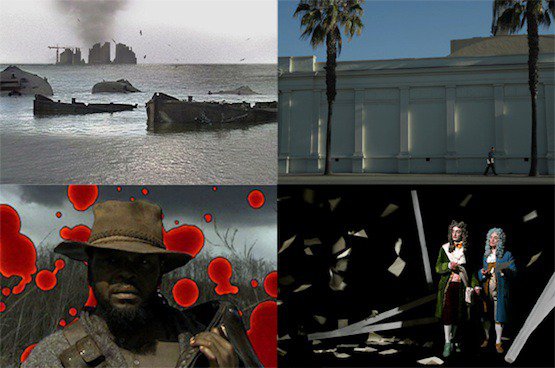Anja Kirschner - David Panos
dal 15/9/2011 al 28/10/2011
Segnalato da
15/9/2011
Anja Kirschner - David Panos
castillo/corrales, Paris
In this series of films, the artists have built their own language dealing with the representation of socio-economic issues that often seem at odds with the presupposed "goals" of art.

A pirates’ tale about urban gentrification (Polly II, 2006). A western movie exploring the logistics of real estate and race (Trail of the Spider, 2008). A period drama dealing with financial bubbles, criminality and the conditions of creation (The Last Days of Jack Sheppard, 2009). And a biopic analyzing the relationships between theory, practice, performance and love in crisis-ridden times (The Empty Plan, 2010). In this series of films, London-based artists Anja Kirschner & David Panos have built their own language – dealing with the representation of socio-economic issues that often seem at odds with the presupposed ‘goals’ of art.
How is it possible to explain the logics and genealogy of semiocapitalism through the ages? What is at stake in acting out / embodying political art? Kirschner & Panos use codified forms of representation such as genre movies and historical plots to give way to a sensitive and striking rendition of theoretical questions. They borrow from literary, artistic and popular culture; Sergio Corbucci’s spaghetti westerns, Hogarth and his engravings of modern mores, the history of pirates Mary Read and Anne Bonny, or Bertolt Brecht’s collaborative relationships with Helene Weigel and Ruth Berlau. The overlap between realism and staged performance in their films brings out a critique of the language of reality, experience and its representation.
Looking back at the deeds of historical figures, recalling how they behaved, how they fought and sometimes lost heart, Kirschner & Panos point out at a shadow history of the ‘artist’ and her/his role in picturing society.
Polly II (2006) est une histoire de pirates et de gentrification ; Trail of the Spider (2008), un western sur fond de spéculation immobilière et de tensions raciales. The Last Days of Jack Sheppard (2009), un film en costumes, décrivant un XVIIIe siècle où la banqueroute morale recoupe les tourments boursiers ; et The Empty Plan (2010), un biopic exploitant le potentiel dramatique des contradictions entre théorie et pratique en temps de guerre. Dans cette série de quatre films, les artistes londoniens Anja Kirschner & David Panos ont mis en place leur propre langage, déjouant les canons du « cinéma d’exposition » pour représenter des phénomènes sociaux, économiques, politiques contemporains.
Comment est-il possible d’expliquer la logique et la généalogie du capitalisme cognitif ? Où se situent les enjeux d’un art politique ? Par le recours à des formes de représentation établies – film de genre, récits historiques – Kirschner & Panos s’attachent à donner une force éloquente à des questionnements abstraits, à éclairer le présent par l’analyse du passé. Leurs films empruntent au style des westerns spaghetti de Sergio Corbucci ou des gravures de William Hogarth, et s’inspirent de figures de femmes hors-la-loi – Mary Read et Anne Bonny, Edgeworth Bess – autant que de la vie et de l’œuvre de Bertolt Brecht, dont les relations avec Helene Weigel et Ruth Berlau sont au cœur de The Empty Plan. Le réalisme des récits et la théâtralité des situations donnent lieu à une critique de la représentation et des modalités de l’expérience : Kirschner & Panos convoquent la mémoire d’hommes et de femmes illustres, de leurs actes, de leurs gestes, de ce contre quoi ils ont dû se battre et ce qui a pu leur faire perdre espoir, pour dresser une histoire sociale de l’art et surtout de l’artiste en chroniqueur de son temps.
This exhibition has been made possible thanks to the support of The British Council
Opening friday 16 september, 6-9pm
Castillo/corrales
80 rue Julien Lacroix Paris
Hours: wed-sat 2-7pm
Admission free



